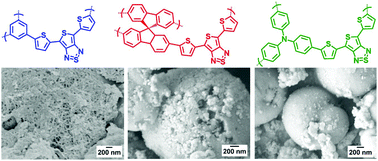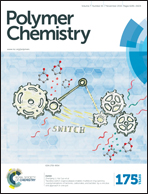Narrow bandgap thienothiadiazole-based conjugated porous polymers: from facile direct arylation polymerization to tunable porosities and optoelectronic properties†
Abstract
Conjugated porous polymers with narrow bandgaps are important for light harvesting in the near infrared region, but are limited by the availability of the appropriate building blocks and synthetic tools. Here we report a series of narrow bandgap conjugated porous polymers synthesized by facile direct arylation polymerization of thiophene-flanked thienothiadiazole with multibrominated monomers with different geometries. The polymer products show strong light absorption in the near infrared region, corresponding to narrow optical bandgaps below 1.3 eV. Under the same polymerization conditions, the morphologies, porosities and optoelectronic properties of the resulting polymers are determined by the chemical structures of the aryl bromides. The synthetic protocol of direct arylation polymerization and the structure–property relationship established in these narrow bandgap conjugated porous polymers will be important for rational material design towards applications such as gas separation/storage and photocatalysis.


 Please wait while we load your content...
Please wait while we load your content...